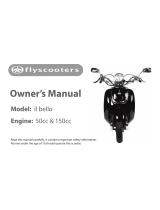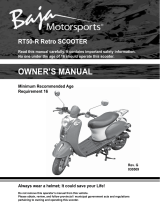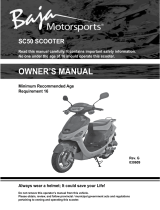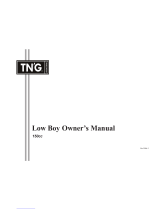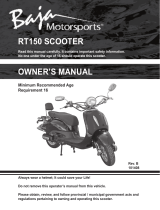Page is loading ...

32S-F8199-13
YW125B
OWNER’S MANUAL
Read this manual carefully before operating this vehicle.
LIT-11626-25-47
6)LQGG

EAU10042
Q
Read this manual carefully before operating this vehicle. This manual should stay with this vehicle if it is
sold.
6)LQGG
ࣉࣟࢭࢫࢩࣥ ࣉࣟࢭࢫ࣐ࢮࣥࢱࣉࣟࢭࢫ࢚࣮ࣟࣉࣟࢭࢫࣈࣛࢵࢡ

INTRODUCTION
EAU10092
Congratulations on your purchase of the Yamaha YW125B. This model is the result of Yamaha’s vast experience in the
production of fi ne sporting, touring, and pacesetting racing machines. It represents the high degree of craftsmanship and
reliability that have made Yamaha a leader in these fi elds.
This manual will give you an understanding of the operation, inspection, and basic maintenance of this scooter. If you
have any questions concerning the operation or maintenance of your scooter, please consult a Yamaha dealer.
The design and manufacture of this Yamaha scooter fully comply with the emissions standards for clean air applicable at
the date of manufacture. Yamaha has met these standards without reducing the performance or economy of operation
of the scooter. To maintain these high standards, it is important that you and your Yamaha dealer pay close attention to
the recommended maintenance schedules and operating instructions contained within this manual.
Yamaha continually seeks advancements in product design and quality. Therefore, while this manual contains the most
current product information available at the time of printing, there may be minor discrepancies between your scooter and
this manual. If there is any question concerning this manual, please consult a Yamaha dealer.
EWA12581
WARNING
Please read this manual and the “YOU AND YOUR MOTORCYCLE: RIDING TIPS” booklet carefully and com-
pletely before operating this scooter. Do not attempt to operate this scooter until you have attained adequate
knowledge of its controls and operating features and until you have been trained in safe and proper riding tech-
niques. Regular inspections and careful maintenance, along with good riding skills, will ensure that you safely
enjoy the capabilities and reliability of this scooter.
6)LQGG
ࣉࣟࢭࢫࢩࣥ ࣉࣟࢭࢫ࣐ࢮࣥࢱࣉࣟࢭࢫ࢚࣮ࣟࣉࣟࢭࢫࣈࣛࢵࢡ

IMPORTANT MANUAL INFORMATION
EAU10132
Particularly important information is distinguished in this manual by the following notations:
Q
This is the safety alert symbol. It is used to alert you to potential personal injury
hazards. Obey all safety messages that follow this symbol to avoid possible injury
or death.
WARNING
A WARNING indicates a hazardous situation which, if not avoided, could result in
death or serious injury.
NOTICE
A NOTICE indicates special precautions that must be taken to avoid damage to the
vehicle or other property.
TIP
A TIP provides key information to make procedures easier or clearer.
6)LQGG
ࣉࣟࢭࢫࢩࣥ ࣉࣟࢭࢫ࣐ࢮࣥࢱࣉࣟࢭࢫ࢚࣮ࣟࣉࣟࢭࢫࣈࣛࢵࢡ

IMPORTANT MANUAL INFORMATION
EAUT2191
YW125B
OWNER’S MANUAL
©2011 by Yamaha Motor Corporation, U.S.A.
1st edition, July 2011
All rights reserved.
Any reprinting or unauthorized use with-
out the written permission of Yamaha
Motor Corporation, U.S.A. is expressly
prohibited.
Printed in Taiwan.
P/N LIT-11626-25-47
6)LQGG
ࣉࣟࢭࢫࢩࣥ ࣉࣟࢭࢫ࣐ࢮࣥࢱࣉࣟࢭࢫ࢚࣮ࣟࣉࣟࢭࢫࣈࣛࢵࢡ

TABLE OF CONTENTS
LOCATION OF IMPORTANT
LABELS .............................................. 1-1
SAFETY INFORMATION .................... 1-3
Further safe-riding points ................. 1-7
DESCRIPTION.................................... 2-1
Left view........................................... 2-1
Right view......................................... 2-2
Controls and instruments ................. 2-3
INSTRUMENT AND CONTROL FUNC-
TIONS.................................................. 3-1
Main switch/steering lock ................. 3-1
Keyhole cover .................................. 3-2
Indicator lights.................................. 3-2
Speedometer unit............................. 3-3
Fuel gauge ....................................... 3-3
Handlebar switches.......................... 3-4
Front brake lever.............................. 3-5
Rear brake lever............................... 3-5
Fuel tank cap.................................... 3-5
Fuel .................................................. 3-6
Catalytic converter ........................... 3-7
Seat.................................................. 3-8
Helmet holder................................... 3-9
Storage compartment....................... 3-9
Sidestand ....................................... 3-10
Ignition circuit cut-off system.......... 3-11
FOR YOUR SAFETY - PRE-OPERATION
CHECKS ............................................. 4-1
OPERATION AND IMPORTANT RIDING
POINTS ............................................... 5-1
Starting the engine........................... 5-1
Starting off........................................ 5-2
Acceleration and deceleration.......... 5-2
Braking............................................. 5-2
Tips for reducing fuel consumption .. 5-3
Engine break-in................................ 5-3
Parking............................................. 5-4
PERIODIC MAINTENANCE AND AD-
JUSTMENT ......................................... 6-1
Owner’s tool kit................................. 6-2
Periodic maintenance chart for the
emission control system ............... 6-3
General maintenance and lubrication
chart.............................................. 6-5
Removing and installing panels ....... 6-9
Checking the spark plug................. 6-10
Engine oil ....................................... 6-11
Final transmission oil...................... 6-13
Air fi lter and V-belt case air fi lter
elements ..................................... 6-14
Checking the engine idling speed .. 6-16
Checking the throttle grip free
play ............................................. 6-16
Valve clearance.............................. 6-16
Tires ............................................... 6-17
Cast wheels.................................... 6-18
Checking the front brake lever free
play ............................................. 6-19
Adjusting the rear brake lever free
play ............................................. 6-19
Checking the front brake pads and
rear brake shoes......................... 6-20
Checking the brake fl uid level ........ 6-21
Changing the brake fl uid ................ 6-22
Checking and lubricating the
cables ......................................... 6-22
Checking and lubricating the throttle
grip and cable ............................. 6-23
Lubricating the front and rear brake
levers .......................................... 6-23
Checking and lubricating the
centerstand and sidestand.......... 6-23
Checking the front fork................... 6-24
Checking the steering .................... 6-25
Checking the wheel bearings......... 6-25
Battery............................................ 6-26
Replacing the fuses........................ 6-27
Replacing a headlight bulb............. 6-28
Tail/brake light................................ 6-29
Replacing a turn signal light bulb ... 6-29
Troubleshooting ............................. 6-30
Troubleshooting chart .................... 6-31
SCOOTER CARE AND STORAGE .... 7-1
Matte color caution........................... 7-1
Care ................................................. 7-1
Storage............................................. 7-3
6)LQGG
ࣉࣟࢭࢫࢩࣥ ࣉࣟࢭࢫ࣐ࢮࣥࢱࣉࣟࢭࢫ࢚࣮ࣟࣉࣟࢭࢫࣈࣛࢵࢡ

TABLE OF CONTENTS
SPECIFICATIONS .............................. 8-1
CONSUMER INFORMATION ............. 9-1
Identifi cation numbers...................... 9-1
Vehicle Emission Control Information
label .............................................. 9-2
Reporting safety defects .................. 9-3
Motorcycle noise regulation ............. 9-4
Maintenance record ......................... 9-5
YAMAHA MOTOR CORPORATION,
U.S.A. RIVA LIMITED
WARRANTY ................................. 9-7
YAMAHA EXTENDED SERVICE
(Y.E.S.) ......................................... 9-9
6)LQGG
ࣉࣟࢭࢫࢩࣥ ࣉࣟࢭࢫ࣐ࢮࣥࢱࣉࣟࢭࢫ࢚࣮ࣟࣉࣟࢭࢫࣈࣛࢵࢡ

1
2
3
4
5
6
7
8
9
1-1
Q
SAFETY INFORMATION
EAU10384
Read and understand all of the labels on your vehicle. They contain important information for safe and proper operation
of your vehicle. Never remove any labels from your vehicle. If a label becomes diffi cult to read or comes off, a replace-
ment label is available from your Yamaha dealer.
EAU45762
LOCATION OF IMPORTANT LABELS
1
2
3
4,5
6)LQGG
ࣉࣟࢭࢫࢩࣥ ࣉࣟࢭࢫ࣐ࢮࣥࢱࣉࣟࢭࢫ࢚࣮ࣟࣉࣟࢭࢫࣈࣛࢵࢡ

1
2
3
4
5
6
7
8
9
1-2
Q
SAFETY INFORMATION
EAU45762
LOCATION OF IMPORTANT LABELS
1
2
3
4
5
175kpa, {1.75kgf/cm
2
},25psi
200kpa, {2.00kgf/cm
2
},29psi
225kpa, {2.25kgf/cm
2
},33psi
200kpa, {2.00kgf/cm
2
},29psi
24P-F1668-00
4JK-F8446-01
6)LQGG
ࣉࣟࢭࢫࢩࣥ ࣉࣟࢭࢫ࣐ࢮࣥࢱࣉࣟࢭࢫ࢚࣮ࣟࣉࣟࢭࢫࣈࣛࢵࢡ

1
2
3
4
5
6
7
8
9
1-3
Q
SAFETY INFORMATION
EAU10269
Be a Responsible Owner
As the vehicle’s owner, you are re-
sponsible for the safe and proper op-
eration of your scooter.
Scooters are single-track vehicles.
Their safe use and operation are de-
pendent upon the use of proper riding
techniques as well as the expertise of
the operator. Every operator should
know the following requirements be-
fore riding this scooter.
He or she should:
● Obtain thorough instructions from
a competent source on all as-
pects of scooter operation.
● Observe the warnings and main-
tenance requirements in this
Owner’s Manual.
● Obtain qualifi ed training in safe
and proper riding techniques.
● Obtain professional technical ser-
vice as indicated in this Owner’s
Manual and/or when made nec-
essary by mechanical conditions.
Safe Riding
Perform the pre-operation checks
each time you use the vehicle to make
sure it is in safe operating condition.
Failure to inspect or maintain the ve-
hicle properly increases the possibility
of an accident or equipment damage.
See page 4-2 for a list of pre-opera-
tion checks.
● This scooter is designed to carry
the operator and a passenger.
● The failure of motorists to detect
and recognize scooters in traf-
fi c is the predominating cause
of automobile/scooter accidents.
Many accidents have been
caused by an automobile driver
who did not see the scooter. Mak-
ing yourself conspicuous appears
to be very effective in reducing
the chance of this type of acci-
dent.
Therefore:
• Wear a brightly colored jacket.
• Use extra caution when you
are approaching and passing
through intersections, since in-
tersections are the most likely
places for scooter accidents to
occur.
• Ride where other motorists can
see you. Avoid riding in another
motorist’s blind spot.
● Many accidents involve inexpe-
rienced operators. In fact, many
operators who have been in-
volved in accidents do not even
have a current driver’s license.
• Make sure that you are quali-
fi ed and that you only lend your
scooter to other qualifi ed op-
erators.
• Know your skills and limits.
Staying within your limits may
help you to avoid an accident.
• We recommend that you prac-
tice riding your scooter where
there is no traffi c until you have
become thoroughly familiar
with the scooter and all of its
controls.
● Many accidents have been
caused by error of the scooter
operator. A typical error made by
the operator is veering wide on
a turn due to excessive speed or
undercornering (insuffi cient lean
Q
SAFETY INFORMATION
6)LQGG
ࣉࣟࢭࢫࢩࣥ ࣉࣟࢭࢫ࣐ࢮࣥࢱࣉࣟࢭࢫ࢚࣮ࣟࣉࣟࢭࢫࣈࣛࢵࢡ

1
2
3
4
5
6
7
8
9
1-4
Q
SAFETY INFORMATION
angle for the speed).
• Always obey the speed limit
and never travel faster than
warranted by road and traffi c
conditions.
• Always signal before turning or
changing lanes. Make sure that
other motorists can see you.
● The posture of the operator and
passenger is important for proper
control.
• The operator should keep both
hands on the handlebar and
both feet on the operator foot-
rests during operation to main-
tain control of the scooter.
• The passenger should always
hold onto the operator, the seat
strap or grab bar, if equipped,
with both hands and keep both
feet on the passenger foot-
rests. Never carry a passenger
unless he or she can fi rmly
place both feet on the passen-
ger footrests.
● Never ride under the infl uence of
alcohol or other drugs.
● This scooter is designed for on-
road use only. It is not suitable for
off-road use.
Protective Apparel
The majority of fatalities from scooter
accidents are the result of head inju-
ries. The use of a safety helmet is the
single most critical factor in the pre-
vention or reduction of head injuries.
● Always wear an approved helmet.
● Wear a face shield or goggles.
Wind in your unprotected eyes
could contribute to an impairment
of vision that could delay seeing a
hazard.
● The use of a jacket, substantial
shoes, trousers, gloves, etc., is
effective in preventing or reducing
abrasions or lacerations.
● Never wear loose-fi tting clothes,
otherwise they could catch on
the control levers or wheels and
cause injury or an accident.
● Always wear protective clothing
that covers your legs, ankles,
and feet. The engine or exhaust
system become very hot during
or after operation and can cause
burns.
● A passenger should also observe
the above precautions.
Avoid Carbon Monoxide Poisoning
All engine exhaust contains carbon
monoxide, a deadly gas. Breathing
carbon monoxide can cause head-
aches, dizziness, drowsiness, nausea,
confusion, and eventually death.
Carbon Monoxide is a colorless,
odorless, tasteless gas which may
be present even if you do not see or
smell any engine exhaust. Deadly
levels of carbon monoxide can collect
rapidly and you can quickly be over-
come and unable to save yourself.
Also, deadly levels of carbon mon-
oxide can linger for hours or days in
enclosed or poorly ventilated areas.
If you experience any symptoms of
carbon monoxide poisoning, leave the
area immediately, get fresh air, and
SEEK MEDICAL TREATMENT.
● Do not run engine indoors. Even
if you try to ventilate engine ex-
haust with fans or open windows
and doors, carbon monoxide can
6)LQGG
ࣉࣟࢭࢫࢩࣥ ࣉࣟࢭࢫ࣐ࢮࣥࢱࣉࣟࢭࢫ࢚࣮ࣟࣉࣟࢭࢫࣈࣛࢵࢡ

1
2
3
4
5
6
7
8
9
1-5
Q
SAFETY INFORMATION
rapidly reach dangerous levels.
● Do not run engine in poorly ven-
tilated or partially enclosed areas
such as barns, garages, or car-
ports.
● Do not run engine outdoors
where engine exhaust can be
drawn into a building through
openings such as windows and
doors.
Loading
Adding accessories or cargo to your
scooter can adversely affect stability
and handling if the weight distribution
of the scooter is changed. To avoid
the possibility of an accident, use ex-
treme caution when adding cargo or
accessories to your scooter. Use extra
care when riding a scooter that has
added cargo or accessories. Here,
along with the information about ac-
cessories below, are some general
guidelines to follow if loading cargo to
your scooter:
The total weight of the operator,
passenger, accessories and cargo
must not exceed the maximum load
limit. Operation of an overloaded
vehicle could cause an accident.
Maximum load:
155 kg (342 lb)
When loading within this weight limit,
keep the following in mind:
● Cargo and accessory weight
should be kept as low and close
to the scooter as possible. Se-
curely pack your heaviest items
as close to the center of the ve-
hicle as possible and make sure
to distribute the weight as evenly
as possible on both sides of the
scooter to minimize imbalance or
instability.
● Shifting weights can create a
sudden imbalance. Make sure
that accessories and cargo are
securely attached to the scooter
before riding. Check accessory
mounts and cargo restraints fre-
quently.
• Properly adjust the suspen-
sion for your load (suspension-
adjustable models only), and
check the condition and pres-
sure of your tires.
• Never attach any large or
heavy items to the handlebar,
front fork, or front fender. Such
items can create unstable
handling or a slow steering re-
sponse.
● This vehicle is not designed to
pull a trailer or to be attached
to a sidecar.
Genuine Yamaha Accessories
Choosing accessories for your vehicle
is an important decision. Genuine
Yamaha accessories, which are avail-
able only from a Yamaha dealer, have
been designed, tested, and approved
by Yamaha for use on your vehicle.
Many companies with no connection
to Yamaha manufacture parts and ac-
cessories or offer other modifi cations
for Yamaha vehicles. Yamaha is not
in a position to test the products that
these aftermarket companies pro-
duce. Therefore, Yamaha can neither
endorse nor recommend the use of
accessories not sold by Yamaha or
6)LQGG
ࣉࣟࢭࢫࢩࣥ ࣉࣟࢭࢫ࣐ࢮࣥࢱࣉࣟࢭࢫ࢚࣮ࣟࣉࣟࢭࢫࣈࣛࢵࢡ

1
2
3
4
5
6
7
8
9
1-6
Q
SAFETY INFORMATION
modifi cations not specifi cally recom-
mended by Yamaha, even if sold and
installed by a Yamaha dealer.
Aftermarket Parts, Accessories,
and Modifi cations
While you may fi nd aftermarket prod-
ucts similar in design and quality to
genuine Yamaha accessories, recog-
nize that some aftermarket accesso-
ries or modifi cations are not suitable
because of potential safety hazards
to you or others. Installing aftermarket
products or having other modifi cations
performed to your vehicle that change
any of the vehicle’s design or opera-
tion characteristics can put you and
others at greater risk of serious injury
or death. You are responsible for inju-
ries related to changes in the vehicle.
Keep the following guidelines in mind,
as well as those provided under
“Loading” when mounting accesso-
ries.
● Never install accessories or carry
cargo that would impair the per-
formance of your scooter. Care-
fully inspect the accessory before
using it to make sure that it does
not in any way reduce ground
clearance or cornering clearance,
limit suspension travel, steering
travel or control operation, or ob-
scure lights or refl ectors.
• Accessories fi tted to the han-
dlebar or the front fork area can
create instability due to improp-
er weight distribution or aerody-
namic changes. If accessories
are added to the handlebar or
front fork area, they must be
as lightweight as possible and
should be kept to a minimum.
• Bulky or large accessories may
seriously affect the stability of
the scooter due to aerodynamic
effects. Wind may attempt to
lift the scooter, or the scooter
may become unstable in cross
winds. These accessories may
also cause instability when
passing or being passed by
large vehicles.
• Certain accessories can dis-
place the operator from his or
her normal riding position. This
improper position limits the
freedom of movement of the
operator and may limit control
ability, therefore, such acces-
sories are not recommended.
● Use caution when adding electri-
cal accessories. If electrical ac-
cessories exceed the capacity of
the scooter’s electrical system, an
electric failure could result, which
could cause a dangerous loss of
lights or engine power.
Aftermarket Tires and Rims
The tires and rims that came with your
scooter were designed to match the
performance capabilities and to pro-
vide the best combination of handling,
braking, and comfort. Other tires,
rims, sizes, and combinations may not
be appropriate. Refer to page 6-15 for
tire specifi cations and more informa-
tion on replacing your tires.
Transporting the Scooter
Be sure to observe following instruc-
tions before transporting the scooter
in another vehicle.
6)LQGG
ࣉࣟࢭࢫࢩࣥ ࣉࣟࢭࢫ࣐ࢮࣥࢱࣉࣟࢭࢫ࢚࣮ࣟࣉࣟࢭࢫࣈࣛࢵࢡ

1
2
3
4
5
6
7
8
9
1-7
Q
SAFETY INFORMATION
● Always wear a helmet, gloves,
trousers (tapered around the cuff
and ankle so they do not fl ap),
and a bright colored jacket.
● Do not carry too much luggage
on the scooter. An overloaded
scooter is unstable.
EAUT2030
Further safe-riding points
● Make sure to signal clearly when
making turns.
● Braking can be extremely diffi cult
on a wet road. Avoid hard brak-
ing, because the scooter could
slide. Apply the brakes slowly
when stopping on a wet surface.
● Slow down as you approach a
corner or turn. Once you have
completed a turn, accelerate
slowly.
● Be careful when passing parked
cars. A driver might not see you
and open a door in your path.
● Railroad crossings, streetcar
rails, iron plates on road con-
struction sites, and manhole
covers become extremely slip-
pery when wet. Slow down and
cross them with caution. Keep the
scooter upright, otherwise it could
slide out from under you.
● The brake lining could get wet
when you wash the scooter. After
washing the scooter, check the
brakes before riding.
● Remove all loose items from the
scooter.
● Point the front wheel straight
ahead on the trailer or in the truck
bed, and choke it in a rail to pre-
vent movement.
● Secure the scooter with tie-downs
or suitable straps that are at-
tached to solid parts of the scoot-
er, such as the frame or upper
front fork triple clamp (and not, for
example, to rubber-mounted han-
dlebars or turn signals, or parts
that could break). Choose the
location for the straps carefully
so the straps will not rub against
painted surfaces during transport.
● The suspension should be com-
pressed somewhat by the tie-
downs, if possible, so that the
scooter will not bounce exces-
sively during transport.
6)LQGG
ࣉࣟࢭࢫࢩࣥ ࣉࣟࢭࢫ࣐ࢮࣥࢱࣉࣟࢭࢫ࢚࣮ࣟࣉࣟࢭࢫࣈࣛࢵࢡ

1
2
3
4
5
6
7
8
9
1-8
Q
SAFETY INFORMATION
6)LQGG
ࣉࣟࢭࢫࢩࣥ ࣉࣟࢭࢫ࣐ࢮࣥࢱࣉࣟࢭࢫ࢚࣮ࣟࣉࣟࢭࢫࣈࣛࢵࢡ

1
2
3
4
5
6
7
8
9
2-1
EAU10401
DESCRIPTION
1. Front turn signal light (page 6-29)
2. Battery (page 6-26)
3. Helmet holder (page 3-9)
4. Sidestand (page 3-10)
5. V-belt case air fi lter cover (page 6-14)
6. Centerstand (page 6-23)
7. Air fi lter (page 6-14)
EAU10410
Left view
8. Rear turn signal light (page 6-29)
EAU10401
DESCRIPTION
1
2
3
4
5
6
7
8
6)LQGG
ࣉࣟࢭࢫࢩࣥ ࣉࣟࢭࢫ࣐ࢮࣥࢱࣉࣟࢭࢫ࢚࣮ࣟࣉࣟࢭࢫࣈࣛࢵࢡ

1
2
3
4
5
6
7
8
9
2-2
EAU10401
DESCRIPTION
EAU10420
Right view
1. Tail/brake light (page 6-29)
2. Muffl er (page 3-7)
3. Storage compartment (page 3-9)
4. Seat (page 3-8)
5. Fuel tank cap (page 3-5)
6. Spark plug (page 6-10)
7. Headlight (page 6-28)
1
23
45
6
7
6)LQGG
ࣉࣟࢭࢫࢩࣥ ࣉࣟࢭࢫ࣐ࢮࣥࢱࣉࣟࢭࢫ࢚࣮ࣟࣉࣟࢭࢫࣈࣛࢵࢡ

1
2
3
4
5
6
7
8
9
2-3
EAU10401
DESCRIPTION
EAU10430
Controls and instruments
1. Rear brake lever (page 6-19)
2. Left handlebar switches (page 3-4)
3. Speedometer unit (page 3-3)
4. Fuel gauge (page 3-3)
5. Brake fl uid reservoir (page 6-21)
6. Right handlebar switches (page 3-4)
7. Front brake lever (page 6-19)
8. Throttle grip (page 5-2)
9. Main switch/steering lock (page 3-1)
12 34
5
6
7
8
9
6)LQGG
ࣉࣟࢭࢫࢩࣥ ࣉࣟࢭࢫ࣐ࢮࣥࢱࣉࣟࢭࢫ࢚࣮ࣟࣉࣟࢭࢫࣈࣛࢵࢡ

1
2
3
4
5
6
7
8
9
3-1
EAU1044E
INSTRUMENT AND CONTROL FUNCTIONS
EAU1044E
INSTRUMENT AND CONTROL FUNCTIONS
EAU45440
Main switch/steering lock
PUSHPUSH
The main switch/steering lock controls
the ignition and lighting systems, and
is used to lock the steering. The vari-
ous positions are described below.
TIP
The main switch/steering lock is
equipped with a keyhole cover. (See
page 3-2.)
EAUT2270
ON
All electrical circuits are supplied with
power, and the meter lighting and tail-
light come on, and the engine can be
started. The key cannot be removed.
TIP
The headlight comes on automatically
when the engine is started and stays
on until the key is turned to “OFF”.
EAU10661
OFF
All electrical systems are off. The key
can be removed.
EWA10061
WARNING
Never turn the key to “OFF” or
“LOCK” while the vehicle is mov-
ing. Otherwise the electrical sys-
tems will be switched off, which
may result in loss of control or an
accident.
EAU10683
LOCK
The steering is locked, and all electri-
cal systems are off. The key can be
removed.
To lock the steering
1
PUSHPUSH
1. Push.
1. Turn the handlebars all the way
to the left.
2. Push the key in from the “OFF”
position, and then turn it to
“LOCK” while still pushing it.
3. Remove the key.
6)LQGG
ࣉࣟࢭࢫࢩࣥ ࣉࣟࢭࢫ࣐ࢮࣥࢱࣉࣟࢭࢫ࢚࣮ࣟࣉࣟࢭࢫࣈࣛࢵࢡ

1
2
3
4
5
6
7
8
9
3-2
EAU1044E
INSTRUMENT AND CONTROL FUNCTIONS
To unlock the steering
1
2
1. Turn.
2. Release.
Push the key in, and then turn it to
“OFF” while still pushing it.
EAUT2111
Keyhole cover
PUSHPUSH
1
1. Keyhole cover lever
To open the keyhole cover
Insert the key bow into the keyhole
cover receptacle as shown, and then
turn the key to the right to open the
cover.
To close the keyhole cover
Push the keyhole cover lever inward
and the keyhole cover will close.
EAU10981
Indicator lights
1
2
3
1. Turn signal indicator light “4 6”
2. High beam indicator light “&”
3. Engine trouble warning light “ ”
EAU11020
Turn signal indicator light “4 6”
This indicator light fl ashes when the
turn signal switch is pushed to the left
or right.
EAU11080
High beam indicator light “&”
This indicator light comes on when the
high beam of the headlight is switched
on.
6)LQGG
ࣉࣟࢭࢫࢩࣥ ࣉࣟࢭࢫ࣐ࢮࣥࢱࣉࣟࢭࢫ࢚࣮ࣟࣉࣟࢭࢫࣈࣛࢵࢡ
/
